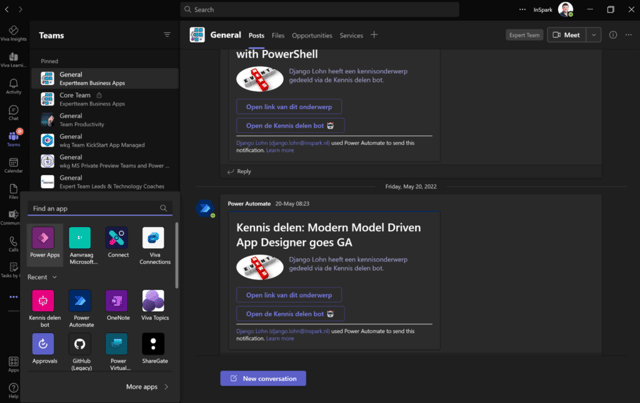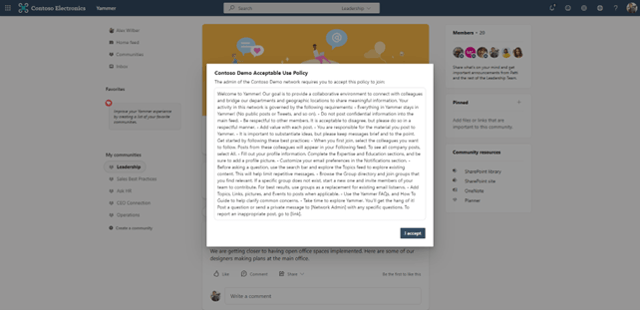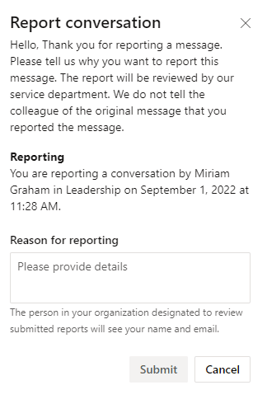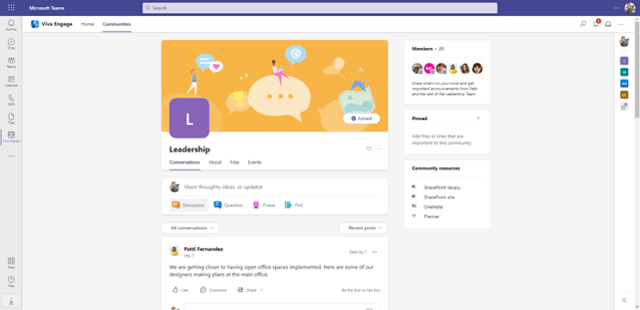In a previous article, we discussed the difference between SharePoint and OneDrive. We are now moving forward and looking at Yammer and how it compares to SharePoint. Frequently, we receive the following question from our customers:
- When should I use SharePoint or Yammer?
- When should I use Microsoft Teams or Yammer?
For us, as consultants in the Microsoft space, the answer to these questions is clear as water. That said, you must remember that not everyone works daily with these Microsoft 365 services.
You need to answer these questions to guarantee a successful adoption rate in your organization. Next to these questions, the IT staff asks us the following question:
- What governance topics are applicable to Yammer and SharePoint?
- What options are available to implement the governance?
In this article, we are going to answer these questions. This helps you increase the adoption rate of SharePoint and Yammer, and you can implement a successful governance strategy in your organization for SharePoint and Yammer.
What is Yammer
Yammer was notoriously acquired in 2012 and had a bumpy start. This basically continued for many years until Microsoft decided to focus on the strengths of Yammer. Connecting a group of people around an area of interest. This was redefined in the concepts of communities:
“Yammer communities enable you to share knowledge and build relationships across your organization.”

In the previous blog, we mentioned looking at Microsoft 365 from an organizational perspective:
- Me: the employee.
- We: the team.
- Us: the organization.
Yammer falls under Us. This is clearly seen in the official description by Microsoft:
“Yammer helps you connect and engage across your organization, so you can discuss ideas, share updates, and network with others.”
The following pillars showcase the strength of Yammer:
- Integrated experience: Access your Yammer conversations within SharePoint with dedicated apps or in Microsoft Teams through Viva Engage.
- Build communities: Connect people around a certain topic or expertise.
- Informal communication: Communicate in an informal manner with your peers.
- Anywhere, anytime, any device: Use the Yammer app to share knowledge and build relationships on the go, anywhere and anytime.
Before you start using Yammer, it is crucial the ask yourself:
“Why do we want to use Yammer?”.
This sounds boring, but you need to define a business case. The majority of failed Yammer implementations didn’t have a business case. There was no clarity, and purpose, for the employees to use Yammer. Especially in the current world, with the overflow of productivity and communication services, business employees need to know why they should use a certain service.
The following resource contains more useful information:
Yammer Governance
In the previous blog, we added an overview of the governance topics for SharePoint Team Sites, Communication Sites and OneDrive. The following topics are applicable for Yammer
- Settings & features
- Design
- Roles & permissions
- Compliance
- Reporting conversations
- Microsoft Teams integration
Let’s take a closer look!
Settings & features
You need to discuss and configure a series of settings before starting with Yammer. These are the following:
- Network name.
- Require users to confirm email messages posted via email before posting (please don’t turn this on).
- Restrict who can upload files and limit file formats (make this as easy as possible).
- Enable or restrict the use of third-party apps (only turn this on when you have a use-case that requires this to be turned on).
- Allow Tenor GIFs in messages (GIFs are awesome, come on!).
- Allow message translation (definitely useful).
The following resource contains useful information:
Design
You need to discuss the branding requirements with your marketing department. The following items are part of the design decisions:
- Microsoft 365 Theme.
- E-mail logo for notification e-mails.
- Community colors and logo.
Try and keep this simple as possible. The following resource contains useful information:
Roles & permissions
An important part of your overall Microsoft 365 governance strategy should be roles & permissions. One of these is administrators. You need to assign multiple Yammer administrators to manage your Yammer network. Be aware: These are administrators and not the people driving the usage and success of Yammer. The following resource contains more information:
Usage policy
We highly recommend activating a usage policy for your Yammer network. You use this to display the purpose of your Yammer network when people start using it for the first time. They need to accept the policy before they can start. This is an important part of your adoption & change management strategy for Yammer.

The following resource contains more information:
Compliance
We advise you to talk with your Chief Information Security Officer about your data compliance requirements. In Yammer you can monitor keywords (for example social security numbers) and determine what needs to happen with deleted messages and how long to keep a certain type of message.
The following resources contain valuable information:
- https://learn.microsoft.com/en-us/yammer/manage-security-and-compliance/manage-data-compliance
- https://learn.microsoft.com/en-us/microsoft-365/compliance/retention-policies-yammer?view=o365-worldwide
- https://learn.microsoft.com/en-us/microsoft-365/compliance/create-retention-policies?view=o365-worldwide
Report a conversation
Although you expect people to be nice and kind, this is not always the case. To prevent unwanted situations, and escalations, we advise enabling the report conversations option. This allows people to report hurtful and offensive conversations.

The following resource contains valuable information:
Delete & restore
Your Yammer users can delete conversations and owners of a community can delete the entire community. Depending on the data retention policies that your verified admin set for your Yammer network, deleted Yammer data may still be available in data exports. If the deleted community was a Microsoft 365 connected group, the Microsoft 365 resources will be available for 30 days. We advise to discuss this with your CISO.
The following resource contains more information:
Microsoft Teams integration
The power of Microsoft Teams is integration with other Microsoft 365 services. We strongly advise integrating Yammer, through Viva Engage, in your Microsoft Teams application. This increases the adoption rate of your Yammer implementation. This is done with the Microsoft Teams App Policies.

The following resource contains more information:
SharePoint & Yammer governance challenges
In our opinion, there is no real governance challenge for Yammer. The governance of Yammer mostly relies around determining and configuring a series of settings. The main challenge is adoption & change management. Yammer needs a business case, and your business users need to understand why Yammer is important for your organization. They will ask you the following questions:
- Why should I use Yammer?
- What does Yammer offer me?
Are you not able to answer these questions? Please stop now and move on. Your Yammer implementation will die a slowly death. That would be a shame because Yammer, or should I say Viva Engage, offers valuable features for each organization.
If Yammer is part of your Microsoft 365 adoption strategy, it’s worth having a complete understanding of that data in relation to the wider Microsoft 365 technologies.
I highly recommend reading the following whitepaper: SharePoint governance best practices. This whitepaper provides best practices to help you compile a modern SharePoint governance strategy to control data access and sharing and provide a better collaboration experience.




